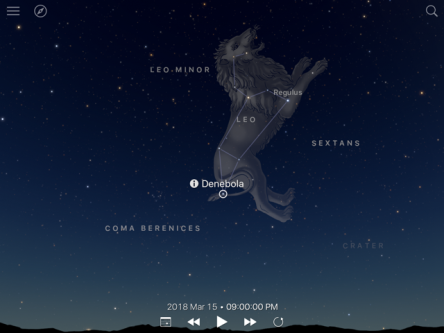
They say that the month of March comes in like a lion and there is actually some truth to that as the spring equinox heralds the arrival of a famous celestial lion, the constellation of Leo. Of the twelve zodiacal constellations (13 if you count Ophiucus, the snake bearer) Leo is one of the most distinctive and easily seen. What’s more, it even looks like its namesake. Better still, Leo is chock full of deep sky objects just waiting for you to track down and bag with a small telescope.
WHEN AND WHERE TO LOOK
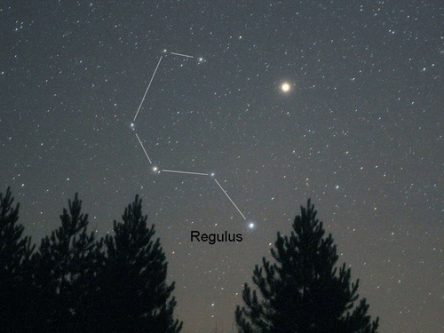
Around mid-March, go outside at 9:00 P.M. and face east. We are looking for 6 stars that form a backwards question mark-shape about halfway up the eastern sky. Be on the lookout for the brightest star in this part of the sky at around this hour. The star is Regulus and it is the brightest star in Leo, it marks the dot at the base of the backward question mark and is also known as “the heart of the lion”. Once you have found this pattern of stars try and imagine them as the mane of the lion’s head. You might also see it more readily as a sickle. In fact, this pattern of six stars is often referred to by amateur astronomers as “the sickle”. The hindquarters of the lion is represented by a triangle-shaped pattern of stars with the tail of the lion denoted by the eastern most star, Denebola, Leo’s second brightest star.
Leo is known as one of the constellations of springtime, but you can see it in the evening sky from around March up until about July. Just be aware that as the weeks go by, the stars of Leo, like all the stars in our night sky, rise earlier and earlier each night and will migrate from east to west, not only hour by hour but also from week to week and from month to month. In other words, if you spot Leo at 9:00 P.M. in the east in mid-March, then you can see him shift further west over the course of the night until he finally sets below the western horizon by dawn. Come back a month later and go out at 9:00 P.M. and you will find that he is no longer due east, instead he will have moved further west, until, by around July he is already in the western sky as soon as the sun goes down. Of course, these motions are not really due to the stars of Leo moving, it is you that is moving as the planet Earth both rotates upon its axis (the hourly motions) as well as the planet making its yearly trek around the Sun (the monthly progression of Leo across the sky).
HISTORY AND MYTHOLOGY
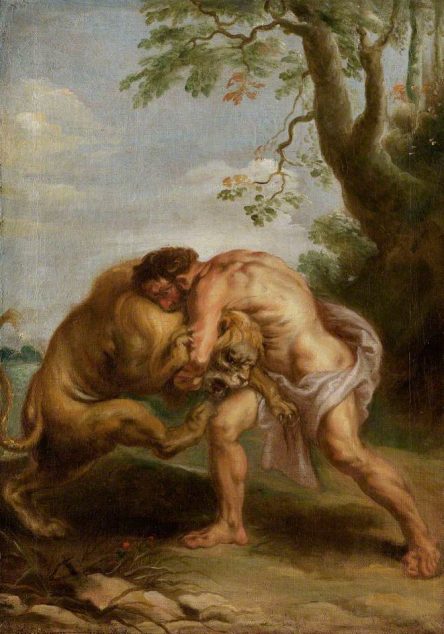
Modern astronomy recognizes Leo as one of the 88 official constellations thanks to Greco-Roman astronomer Ptolemy having cataloged it in his 2nd century A.D. work, The Almagest but it has an even longer history than this. Ancient cultures such as the Persians, Babylonians, Egyptians and Indians all saw a crouching lion in this part of the sky and their myths about it were later assimilated by the Greeks and Romans. To the Chinese however, the sickle in Leo was part of another constellation that, to them, represented a dragon.
In Greek mythology, Leo is said to represent the fearful Nemean Lion. Nemea is a small town outside of Corinth that was being terrorized by a man-eating lion thought to be lurking in a nearby cave. No one knew exactly where the lion came from, rumor had it that he was sired by the monster Typhon while others said he fell from the moon as a meteor, but one thing that all agreed upon was that the lion was trouble and that a hero was needed to get rid of it ASAP. Enter Hercules.
The tale of Hercules is an epic story filled with adventure and more than its fair share of tragedy. Hercules was the illegitimate and immortal son of Zeus (one of many it seems) and he therefore earned the enmity of Zeus’s wife Hera. While Hera couldn’t kill Hercules, she was always finding creative ways to make his life miserable. At one point she places a curse upon Hercules that makes him go insane from time to time. After one of these bouts of madness, Hercules regains his senses only to discover that he has murdered his wife and children. In order to atone for his crime, Hercules is sent to serve Eurystheus, king of Mycenae, for a period of 12 years. Eurystheus presents Hercules with a set of 12 impossible tasks, the first of which is to go kill the Nemean Lion. “Kill a lion? That doesn’t sound so impossible”, I can hear you saying. Ah, but what you don’t know is that the Nemean Lion has a skin that is impervious to all weapons. Yeah, doesn’t sound so easy now, does it.
Faced with this near impossible task, Hercules sets off to confront the killer lion inside its den. After a long and drawn out fight, Hercules finally kills the lion by strangling it with his bare hands. Not being one to waste a perfectly good hide that is impervious to weapons, Hercules rips a claw from the dead lion to use as a knife in order to skin the beast and turn its pelt into a fashion accessory that he can wear into battle. As to how successful Hercules was in finding sandals to match the cape, history has remained silent.
WHAT YOU ARE SEEING
Notable Stars in Leo
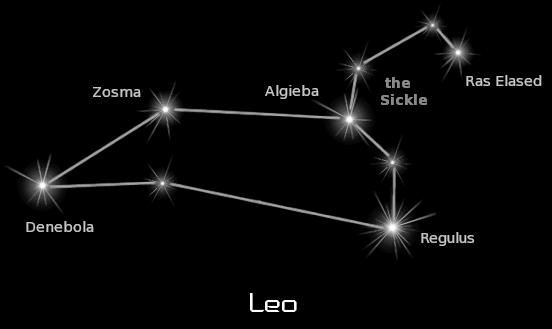 Regulus is the alpha star in Leo and is the 22nd brightest star in our night sky. While it looks like a single star to the unaided eye, Regulus is in fact a multi-star system located some 77 light years away. Regulus A is a blue-white main sequence star that is orbited by a small companion that cannot be visually observed but is likely a white dwarf star. “Main sequence” means that the star is in a stable part of its life cycle and is still using hydrogen as its primary fuel source within the core while “blue-white” refers to the category of stellar classification to which Regulus belongs. Astronomers use a shorthand way of categorizing stars into one of seven main types based upon their temperatures. This system uses the letters, in decreasing order of temperature: O,B,A,F,G,K, and M. Regulus A is a B-type star with a surface temperature of about 21,000 degrees F (our sun has a surface temperature of about 10,000 degrees F).
Regulus is the alpha star in Leo and is the 22nd brightest star in our night sky. While it looks like a single star to the unaided eye, Regulus is in fact a multi-star system located some 77 light years away. Regulus A is a blue-white main sequence star that is orbited by a small companion that cannot be visually observed but is likely a white dwarf star. “Main sequence” means that the star is in a stable part of its life cycle and is still using hydrogen as its primary fuel source within the core while “blue-white” refers to the category of stellar classification to which Regulus belongs. Astronomers use a shorthand way of categorizing stars into one of seven main types based upon their temperatures. This system uses the letters, in decreasing order of temperature: O,B,A,F,G,K, and M. Regulus A is a B-type star with a surface temperature of about 21,000 degrees F (our sun has a surface temperature of about 10,000 degrees F).
Regulus B and C orbit a bit further out from the primary, B can be seen with binoculars while large telescopes are needed to pick out C. The name “Regulus” is from the Latin, meaning “Little King” or “prince”.
Denebola is the second brightest star in Leo and 61st brightest in our night sky. The name comes from an Arabic phrase meaning, “the tail of the lion”. Denebola is an A-type star that is 75% more massive than the Sun and some 12 times as luminous. It is also a variable star, meaning that its luminosity changes over time. Variable stars change their brightness due to any number of things but in this case, it seems to be due to the star being a very fast rotator. Our Sun takes about a month to rotate once upon its axis, but Denebola does it in just 0.65 days. This fast spin means that Denebola is shifting a lot of mass around pretty quickly and this creates sudden changes in brightness every few hours. Age estimates place Denebola at about 400 million years old, quite young in cosmic terms.
Wolf 359 is a red dwarf star located some 8 light years away. Red dwarfs are, as the name implies very small and very dim stars, they appear to be at right around the threshold for what it takes for a star to be a star. Designated as an M-type star, Wolf 359 is one of the lowest mass stars yet found and one of the dimmest. It has about 8% of the Sun’s mass and emits only about 0.01% of its energy. At first glance you might be tempted to think that red dwarfs must be very rare but in fact they are quite common and account for about 75% of the stellar population in our Milky Way Galaxy. But, because they are small, dim, and very far away, we just don’t get to see very many in our night sky. Eight light years is very close to Earth on a cosmic scale, but you will still need a small telescope to see Wolf 359.
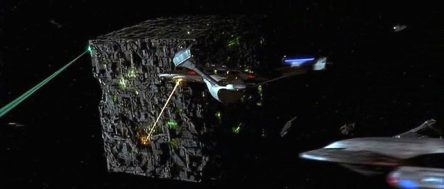
Star Trek: The Next Generation fans will recall Wolf 359 as being the location where Captain Picard, having been assimilated by the Borg, led the cyborg fleet of cube-shaped ships in a battle against Starfleet ships. The Borg devastated the Starfleet armada and left few survivors. One of the few that did survive was Benjamin Sisko who would one day become captain of Deep Space Nine, a space station located near a stable wormhole in the Bajor system.
DEEP SKY OBJECTS IN LEO
When you look in the direction of Leo, you are looking outside the plane of our Milky Way Galaxy. In other words, you are looking into intergalactic space and the most common type of deep sky object to be found here by the amateur astronomer will be galaxies and when it comes to galaxies, Leo does not disappoint. There are well over a dozen galaxies to be found in this area of the sky and because they are all at ninth magnitude or greater, you are going to need a telescope or good binoculars to see them.
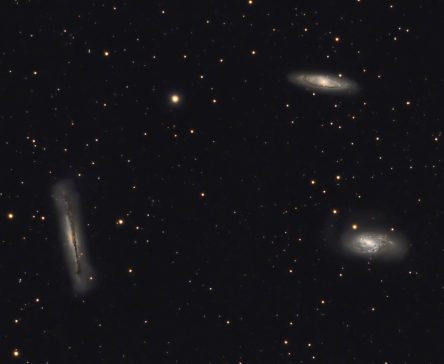 Leo contains far too many galaxies to discuss each in detail here, but I recommend getting a good star atlas and astronomy field guide should you decide to go galaxy hunting from your own backyard. However, let’s take a quick look at three of Leo’s most well-known galaxies: M65, M66, and NGC 3628, otherwise known as the Leo Triplet.
Leo contains far too many galaxies to discuss each in detail here, but I recommend getting a good star atlas and astronomy field guide should you decide to go galaxy hunting from your own backyard. However, let’s take a quick look at three of Leo’s most well-known galaxies: M65, M66, and NGC 3628, otherwise known as the Leo Triplet.
To find the Leo Triplet, wait until you have a night with no moon and make sure that you are at a location with decently dark skies. Now, grab your gear and star atlas or field guide and let’s begin the hunt. Find Denebola, the easternmost star in the triangle that forms the hind quarters of Leo. Now, locate Chertan (Theta Leonis), the star that makes up the westernmost corner of the triangle’s base. Using the star atlas, locate Iota Leonis, a star to the south-southeast of Chertan. The triplets are about midway in between a line drawn from Chertan to Iota.
With a pair of binoculars, you will most likely only be able to spot M65 and M66 as a pair of hazy smudges, NGC 3628 just isn’t bright enough. But even with a small 4-inch telescope you should be able to capture all three in one field of view and with a scope, you should begin to see more details. You will immediately note that M65 is the brightest of the triplets and that it stands out more so than does its siblings. Now, pause and consider that the collective light from these galaxies is made up from the combined fire power of over half a trillion individual stars and that those photons have been traveling for 35 million years before finally bouncing around the inside of your eyeballs on this particular night.
The members of the Leo Triplet are all spiral galaxies and they are oriented to our line of sight in different ways. M65 and M6 are both tilted in such a way that we can easily tell that they have a spiral structure. However, NGC 3628 is seen as an edge-on galaxy so that through a telescope it will appear as a faint needle-shaped smudge. We know that the triplet members are all gravitationally bound to one another and that gravity has distorted and warped the shape of these spirals as they have interacted with one another over time. But hold on to your popcorn, in a few billion years, all three of these galaxies will eventually collide into one another, creating a massive elliptical galaxy when it’s all said and done. A fender bender of cosmic proportions.